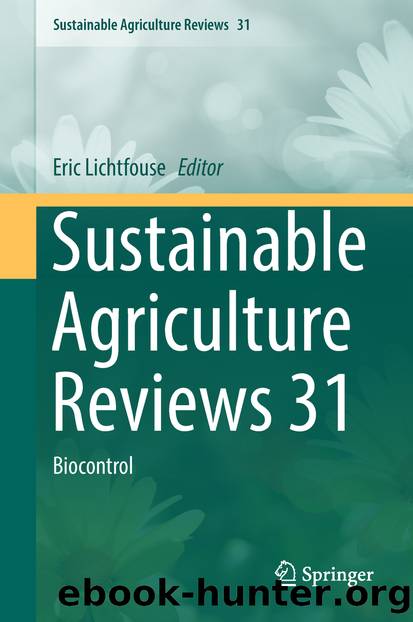Sustainable Agriculture Reviews 31 by Unknown

Author:Unknown
Language: eng
Format: epub
ISBN: 9783319942322
Publisher: Springer International Publishing
After pesticide application, 20 3-instar larvae were placed in the soil. The flasks were sealed with voile fabric and incubated at 27 ± 0.5 °C for nine days, until adult emergence; incubation continued for four more days at room temperature . The total insect survival was significantly affected and pathogenic activity was detected from the pupa stage on. Pupa survival was reduced (P < 0.05); the same occurred during the adult phase. No effect was observed at the larval stage. The pesticides applied to the soil affected the activity of M. anisopliae slightly: Only in the dry conidia assay the fungicides chlorothalonyl and tebuconazole reduced (86.2 and 82.5%, respectively) the survival period of C. capitata compared to the control (95.0%). The techniques used for conidia application did not influence the total insect survival rate, but conidial suspension applied on soil surface reduced survival during the pupae and adult phases (Mochi et al. 2006). Weedicides also appeared to be toxic but level of toxicity was low as evidenced from inhibition of fungal growth from 10.26 to 26.07%. There was no significant variation between attrazin, nitrofen, glyphosate and pendimethalin (23.07%), but the toxicity was more than two times of 2,4-D and butachlor inhibited 10.26 and 12.39% respectively (Rachappa et al. 2007). Li and Holdom (1994) also reported absolute safety of 2,4-D. Chemical constituents of weedicides, mostly being selective to specific group of plants may not exert toxicity to fungal spores.
Moorhouse et al. (1992) also found little correlation between in vitro laboratory studies and in situ applications of fungicides and insecticides for M. anisopliae. In their studies, there were some indications that reduced germination in vitro may be linked to reduced infection rates in soil, but this relationship was not significant. This was not the case in the acaricide, insecticide and herbicide treatment (Mochi et al. 2006). Based on fungal respiratory activity, the toxic action of a range of pesticides (acaricides, fungicides, insecticides and herbicides) on M. anisopliae in the soil is small, suggesting little negative impact on the fungal activity resulting from their use (Mochi et al. 2005). In the rhizosphere soil, some fungicides tested in these studies significantly reduced the number of M. anisopliae CFU. To my knowledge, this is the first study to consider the impact of fungicides on entomopathogenic fungal populations in the rhizosphere. The biology of entomopathogenic fungi outside of their role as entomopathogens is becoming an increasingly important area of study. The potential of utilizing rhizosphere competent entomopathogenic fungi is great and any adverse effect that chemical fungicides have on the fungal population in the rhizosphere must be considered. If the fungus is not able to persist and proliferate in the rhizosphere it may not be present at levels adequate to control BVW larvae feeding on the roots. There was no significant increase in the M. anisopliae populations in the rhizosphere in this study relative to the bulk soil populations as was observed by Bruck (2005). It can take as long as 8–10 weeks for fungal populations to increase significantly in the rhizosphere (unpublished data).
Download
This site does not store any files on its server. We only index and link to content provided by other sites. Please contact the content providers to delete copyright contents if any and email us, we'll remove relevant links or contents immediately.
Fanny Burney by Claire Harman(26526)
Empire of the Sikhs by Patwant Singh(22974)
Out of India by Michael Foss(16791)
Leonardo da Vinci by Walter Isaacson(13181)
Small Great Things by Jodi Picoult(7019)
The Six Wives Of Henry VIII (WOMEN IN HISTORY) by Fraser Antonia(5394)
The Wind in My Hair by Masih Alinejad(5033)
A Higher Loyalty: Truth, Lies, and Leadership by James Comey(4843)
The Lonely City by Olivia Laing(4748)
The Crown by Robert Lacey(4722)
Millionaire: The Philanderer, Gambler, and Duelist Who Invented Modern Finance by Janet Gleeson(4374)
The Iron Duke by The Iron Duke(4291)
Papillon (English) by Henri Charrière(4195)
Sticky Fingers by Joe Hagan(4100)
Joan of Arc by Mary Gordon(4013)
Alive: The Story of the Andes Survivors by Piers Paul Read(3968)
Stalin by Stephen Kotkin(3875)
Aleister Crowley: The Biography by Tobias Churton(3586)
Ants Among Elephants by Sujatha Gidla(3417)
